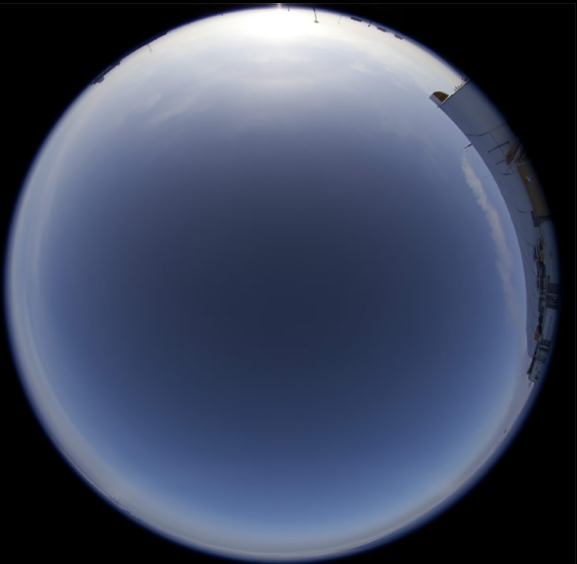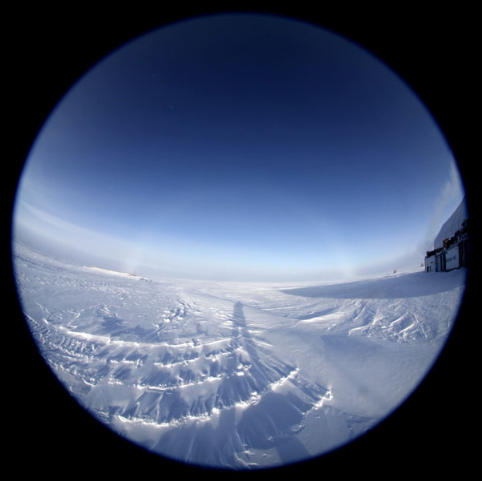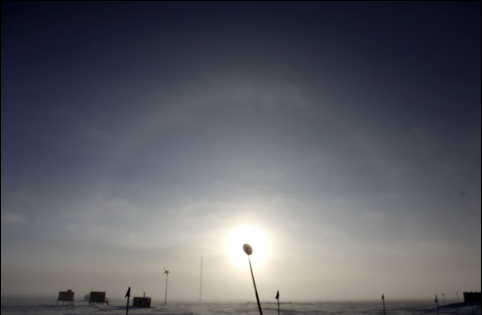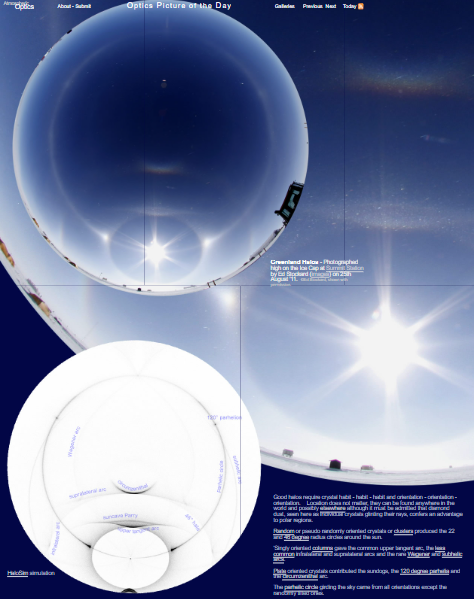OPOD - Bouguer's Halo
Bouguer's Halo: A Rare Atmospheric Optics Phenomenon
Bouguer's Halo is a fascinating and rare atmospheric optics phenomenon that has recently gained attention due to its simultaneous appearance with a fogbow and a halo. Located at Summit Station on the Greenland Ice Cap, this site has become renowned for its rich displays of atmospheric optics, captivating observers and photographers alike.
Enhanced Viewing Experience
Summit Station's webcam, installed by David Noone on a 50m tower, has been modified to better capture atmospheric phenomena, thanks to the suggestion of Jari Luomanen, an optics enthusiast from Finland. Jari, who closely monitors the webcam, spotted the Bouguer's Halo at approximately 10 am Greenland time on October 14th. He immediately alerted Ed Stockard, a veteran optics observer and photographer stationed at Summit Station. Despite being about to head outside for work, Ed quickly grabbed his camera and ventured into the -33 Celsius air to capture this extraordinary event.
The Debate: Human Observers vs. Automatic Cameras
There has been an ongoing debate regarding the impact of automatic cameras on the discovery of new halo phenomena. While robots and automated systems like SOHO have revolutionized comet discovery, the consensus is that experienced and dedicated human observers are still necessary to monitor the output of these cameras and promptly alert local photographers. The presence of an alert and knowledgeable observer adds a level of excitement to the halo chase, which may be lost if webcams were to take over entirely. However, as technology continues to advance, the future role of human observers in halo discoveries remains uncertain.
The Unique Rarity of Bouguer's Halo
Fogbows and 22° halos are relatively common atmospheric optics occurrences. However, the simultaneous appearance of these two phenomena, as seen in Bouguer's Halo, is exceptionally rare and remarkable. Fogbows are formed when small fog droplets, ranging from 5 to 50 microns in diameter, refract, reflect, and diffract sunlight. In the case of Bouguer's Halo, these droplets were supercooled. On the other hand, ice halos result from the refraction and reflection of light by relatively large ice crystals measuring 100 to 1000 microns in size.
The Thermodynamic Impossibility
The uniqueness of Bouguer's Halo stems from the fact that water droplets and ice crystals cannot coexist in a stable mixture, except at a specific temperature and pressure known as the "triple point." This triple point occurs at a temperature of 0.01°C and a pressure of 6.1 mbar. Above zero degrees, ice becomes unstable, while below zero degrees, water droplets are unstable. Therefore, thermodynamically speaking, the long-lived presence of a Bouguer halo resulting from a mixture of water droplets and ice crystals is considered impossible.
Metastable States and Phase Transitions
At subzero temperatures, water droplets can remain in a metastable state if there are no significant surfaces or nuclei for water vapor to condense onto and form ice. However, when nuclei are introduced, such as in the case of Bouguer's Halo, the transformation from supercooled water fog to diamond dust ice crystals occurs suddenly. This phase change involves the rapid growth of ice crystals while water droplets evaporate due to the lower vapor pressure of ice compared to supercooled water. This sudden transition is also responsible for other atmospheric phenomena like hole-punch clouds and the trailing virga of halo-forming ice crystals.
Rare Moments of Coexistence
Experiences from Finland, where displays of both fogs and diamond dusts have been observed, suggest that moments when halos and fogbows appear simultaneously are incredibly brief. In most cases, these occurrences last only a matter of seconds. When captured in photographs, it may appear as if fog and diamond dust stages are seen together, but this is primarily due to the time exposure capturing both phenomena on film. These rare moments of coexistence typically happen when the moon is not shining through due to the thickness of the diamond dust and fog or when the sky is overcast.
Exploring Potential Influences
In analyzing the images of Bouguer's Halo, attention has been drawn to a plume visible at the far right of the top image. Some have speculated whether this plume could have introduced the water droplets that formed the fogbow. However, Ed Stockard, the photographer, dismisses this possibility. He clarifies that the plume originates from a generator exhaust and is situated quite a distance north of the fogbow. Moreover, given previous observations, if the plume were indeed responsible for the fogbow, it would have likely been noticed before. It is worth noting that while there are other triple points in the water-ice system, they occur at pressures significantly higher than those present in our atmosphere.
In conclusion, Bouguer's Halo represents an extraordinary and infrequent combination of atmospheric optics phenomena. The simultaneous appearance of a fogbow and a halo is a captivating sight that has sparked interest among both observers and researchers. While automatic cameras may play a role in future discoveries, the expertise and dedication of human observers remain invaluable in monitoring and documenting these awe-inspiring events. The study of Bouguer's Halo and other rare atmospheric optics occurrences continues to deepen our understanding of the complex interplay between light, water droplets, and ice crystals in our atmosphere.
Optics Picture of the Day

Bouguer's Halo
Summit Station on the Greenland Ice Cap is getting a reputation for rich displays of atmospheric optics. Here we have “Bouguer’s Halo” the very rare simultaneous appearance of a fogbow and a halo. Mouse over the image for an enhanced view. More about why this ‘halo’ is exceptional below.
Summit Station has a webcam installed by David Noone on a 50m tower and recently it was modified at the suggestion of Jari Luomanen (optics site) to better show atmospheric phenomena. Jari watches it assiduously from Finland and at ~10am Greenland time on October 14th he spotted the Bouguer's halo and right away e-mailed veteran optics observer and photographer Ed Stockard (photostream) at the Station. Ed was just about to go outside to work rather than halo watch. On Jari's alert he grabbed a camera and emerged into the -33 Celsius air. The sun was shining through a thin fog with blue sky still visible. Ed took images sunwards (the 22° halo), opposite the sun (fogbow) and the fisheye view at left.
There’s been a debate since about the impact of automatic cameras on making new halo discoveries. Will robots take over halo discoveries as SOHO now routinely finds new comets? The consolation at the moment is that an experienced and dedicated halo observer is needed to watch the output and quickly alert an experienced local photographer. If ever that ceases to be then we can debate whether to put hoods over the webcams to restore the excitement of the halo chase when out under the sky!
Images ©Ed Stockard, shown with permission

What is so special about Bouguer's halo?
Fogbows and 22° halos are relatively common. Why is their simultaneous appearance remarkable? Fogbows are produced when small fog droplets (5 to 50 micron diameter) refract, reflect and diffract sunlight. In this sighting the droplets were supercooled. Ice halos are from the refracted and reflected light from quite large (100 to 1000 micron) ice crystals.
The Bouguer’s halo rarity comes because water droplets and ice crystals cannot co-exist in a stable mixture except at one.. unique temperature and pressure, the 'triple point' at 0.01 C and 6.1 mbar. Above zero, ice is unstable. Below zero water droplets are unstable. Thermodynamically, a natural long-lived Bouguer halo from a water drops and ice mixture is an impossibility.
At subzero temperatures water droplets can remain in a metastable state if there are no significant surfaces or nuclei onto which water vapour can condense into ice. But when nuclei are introduced the transformation from a supercooled water fog into diamond dust ice crystals is sudden. The vapour pressure of ice is less than that of supercooled water and so water drops evaporate while ice crystals grow rapidly. This sudden phase change is responsible for hole-punch clouds and their trailing virga of halo forming ice crystals.
Marko Riikonen writes: “My experience from Finland is that you either have fog or diamond dust. On the two occasions I have seen a display where fogs and diamond dusts passed and the moments when halos and fogbow were seen at the same time lasted just seconds. In photos these mostly show up together only because the time exposure had captured both fog and diamond dust stages on film.
In the first case the diamond dust and fog were too thick to let the moon shine through. In the second the sky was overcast. This latter type of occurrence if rather rare - you don't often have diamond dust of fog under cloud cover.”
Ed Stockard comments on the plume at far right, top image, could it have introduced the water droplets that formed the fogbow? "On this day I am quite certain the answer is no. The plume is from our generator exhaust and is a fair amount north of the fogbow. I also think if this were the case we would have seen it before now. I had thought about this as well."
.. To be pedantic, there are other triple points in the water-ice system but they are at pressures way above those in our atmosphere.


Note: this article has been automatically converted from the old site and may not appear as intended. You can find the original article here.
Reference Atmospheric Optics
If you use any of the definitions, information, or data presented on Atmospheric Optics, please copy the link or reference below to properly credit us as the reference source. Thank you!
-
<a href="https://atoptics.co.uk/blog/opod-bouguers-halo/">OPOD - Bouguer's Halo</a>
-
"OPOD - Bouguer's Halo". Atmospheric Optics. Accessed on December 23, 2024. https://atoptics.co.uk/blog/opod-bouguers-halo/.
-
"OPOD - Bouguer's Halo". Atmospheric Optics, https://atoptics.co.uk/blog/opod-bouguers-halo/. Accessed 23 December, 2024
-
OPOD - Bouguer's Halo. Atmospheric Optics. Retrieved from https://atoptics.co.uk/blog/opod-bouguers-halo/.